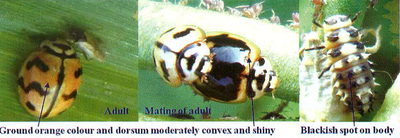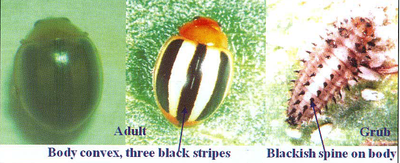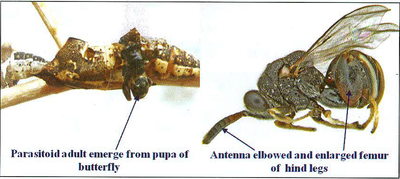Natural Enemies of Fruit Crops in Arid Region
Natural Enemies of Fruit Crops in Arid Region
Praying mantid (Mantis religiosa)
- Praying mantis or praying mantids are carnivorous (meat-eating) insects. There are about 2,000 different types of mantids.
Prey habitat
- Praying mantids are highly predacious and feed on a variety of insects, including moths, crickets, grasshoppers and flies.
- They lie in wait with the front legs in an upraised position. They intently watch and stalk their prey. They will eat each other.
Description
- The biggest are over 15 cm long and the smallest are about 1 cm long.
- Three distinct body regions: head, thorax (where the legs and wings are attached), abdomen. Part of the thorax is elongated to create a distinctive ‘neck’.

- Front legs modified as raptorial graspers with strong spikes for grabbing and holding prey.
- Large compound eyes on the head which moves freely around (up to 180°) and three simple eyes between the compound eyes.
- Incomplete or simple metamorphosis (hemimetabolous).
- A distinct Styrofoam-like egg case protects Mantid eggs throughout the winter. Up to 200 or more nymphs may emerge from the egg case.
- The nymphs look like adults except for size and the sexual definition.
Zigzag ladybird beetle (Cheilomenes sexmaculata)
- Present almost throughout India and the Oriental region, Iran, Australasia etc.
Prey habitat
- Aphidophagous, also feeds on psyllids, whiteflies, mealybugs, tingids, leaf and planthoppers, mites, and early instar lepidopteran larvae.
Description
- Body is oval to subrounded, dorsum moderately convex and shiny.
- Length 3.3-6.2 mm and width 3.0-5.3 mm.
- Ground colour orange, light red, yellow or pinkish with the following markings in the typical form.
- Head with a black marking in posterior half.
- Pronotum with a T-shaped median marking connected to a broad black band along posterior margin.

- Elytra with six black maculae including two zigzag lines and a posterior black spot.
Strip lady bird beetle (Brumoides suturalis)
- Widespread almost throughout India (Andhra Pradesh, Goa, Jammu & Kashmir, Karnataka, Kerala, Manipur, Punjab, Tamil Nadu, Uttar Pradesh, West Bengal), Nepal, Bhutan,Sri Lanka, etc.
Prey habitat
- This species departs from the normal food habits of the other genera of Chilocorini, which are mainly scale feeders.
- It is more polyphagous and largely predatory on aphids, whiteflies, psyllids, scales, mealybugs and mites.
Description
- Body is oval, dorsum convex. Body length is 4.0 mm and width 2.7 mm.
- Head and pronotum orange yellow.
- Scutellum black.
- Elytra satiny white to creamy yellow, with three black stripes, one on each elytron in a mid-dorsal position not extending to apex and one along sutural line nearly extending to apex.

- Apical portion yellowish to reddish brown.
- Last visible abdominal segment with posterior margin emarginate in male and narrowly rounded in female.
- Larva slaty grey, with prominent spiny protuberances on dorsal side.
Green lacewing (Chrysoperla carnea)
- It is found in many parts of America, Europe and Asia. It was originally considered to be a single species with a holarctic distribution but it has now been shown to be a complex of many cryptic, sibling species.
Prey habitat
- The adults feed on nectar, pollen and aphid honeydew but the larvae are active predators and feed on aphids and other small insects.
Description
- The green lacewing eggs are oval and secured to the plant by long slender stalks.
- The larvae are brown and resemble small alligators, crawling actively around in search of prey.

- They have a pair of pincer-like mandibles on their head with which they grasp their prey, sometimes lifting the victim off the leaf surface to prevent its escape.
- Adult green lacewings are a pale green colour with long, threadlike antennae and glossy, golden, compound eyes.
- They have a delicate appearance and are from twelve to twenty millimetres long with large, membranous, pale green wings which they fold tent-wise above their abdomens.
- They are weak fliers and have a fluttery form of flight.
Ker butterfly parasitoid (Brachymeria albicrus)
- The parasitoid has a worldwide distribution. During the surveys conducted in Rajasthan, Brachymeria albicrus was found parasitizing Anaphaeis aurota infesting ker plant.
Parasitoid habit
- It is a parasitoid of ker butter fly, Anaphaeis aurota
Description
- The parasitoid have elbowed antenna and have a typically enlarged femur (thigh) segment on the hind legs.
- The female typically lays eggs inside the larva of a Lepidopteron using its ovipositor.

- The adult parasitoid emerges typically from the pupa.
- The mean percent parasitism of the butterfly by B. albicrus at CIAH farm and at Desnok, Bikaner was 49.5 and 47.5 respectively and the mean percent emergence of the mature adult parasitoids from the parasitized pupae was 15.5 and 14.0 respectively.
Source: Insect Pest of Arid Fruit Crops
Last Modified : 2/13/2020
© C–DAC.All content appearing on the vikaspedia portal is through collaborative effort of vikaspedia and its partners.We encourage you to use and share the content in a respectful and fair manner. Please leave all source links intact and adhere to applicable copyright and intellectual property guidelines and laws.
RELATED ITEMS
